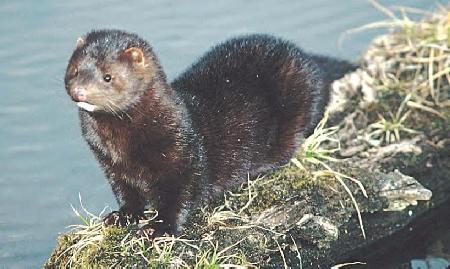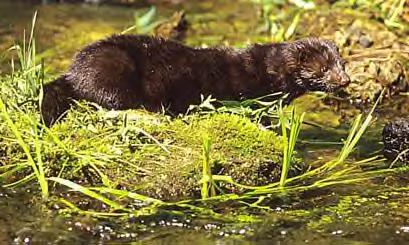|
|
Canku Ota |
|
|
(Many Paths) |
||
|
An Online Newsletter Celebrating Native America |
||
|
July 26, 2003 - Issue 92 |
||
|
|
||
|
Mink, Raven and the Sea Eggs |
||
|
by Northwest Coastal Legend |
||
|
So it happened one day that the Mink, and his brother, the Raven were paddling along in their canoe. It was a lovely day, it was hot and it was calm. There was no wind blowing, so the water was still and clear. They happened to look down into the clear water, and there, they seen allot of nice looking Sea Eggs (Urchins) at the bottom of the ocean. So Mink told his brother, Raven, to stop paddling along said, "Look at all those lovely looking food showing at the bottom of the water. They really must taste good." After saying that, he took a hold of a basket made from young pliable red cedar limbs, and he dove to the bottom. Whenever he got the basket full, he would come to the surface and pass the basket to his brother, the Raven, who would empty the basket into the canoe and hand the basket back to his brother the Mink.
The people were very thankful and showed a lot of respect to Mink, because they knew that he must have worked hard to accumulate so much of this good food. There for, all thanked him. So brother Raven, felt left out, because everyone was thanking and making such a fuss over Mink, and not paying any attention to him. One day Raven got into his canoe. He was all alone. He took off, he did not want to share his reward of thanks with anyone when he returned home with his canoe loaded with those lovely Sea Eggs. He wanted to be the only one to receive respect and thanks, so he paddled for the place where Mink seen and got all those lovely Sea Eggs.
He took the basket in his hand and dove to the bottom. But, to his disappointment, he discovered that he was unable to submerge. He tried and continued on trying until he passed out. He drifted up to the beach. He was semi-conscious and his canoe had gone adrift. He laid there, more dead than alive. It happened that some of his people were passing by, they seen him on the beach and approached him and inquired what had happened.
Print and Color Your Own Mink Picture |
|
|

 In
the long ago, all the animals and birds were still human being
and all regarded each other as sister and brothers.
In
the long ago, all the animals and birds were still human being
and all regarded each other as sister and brothers.
 Again
the Mink would dive to the bottom and load the basket and again
he would surface. He kept on doing that until the canoe was loaded
with great big Sea Urchins, then they headed their canoe for home.
When they arrived, they got ashore, then Mink invited all of the
people to come to come down and have a feast of Sea Eggs.
Again
the Mink would dive to the bottom and load the basket and again
he would surface. He kept on doing that until the canoe was loaded
with great big Sea Urchins, then they headed their canoe for home.
When they arrived, they got ashore, then Mink invited all of the
people to come to come down and have a feast of Sea Eggs. When
he arrived there, he looked at the bottom of the water, he seen
all of them lovely, tasting Sea Eggs. He didn't hesitate. he got
a hold of a red cedar bough basket and prepared himself for a dive
to the bottom of the water, for he knew that the sooner he got his
canoe loaded and returned home, the sooner he would get his many
thanks and the respect of the people.
When
he arrived there, he looked at the bottom of the water, he seen
all of them lovely, tasting Sea Eggs. He didn't hesitate. he got
a hold of a red cedar bough basket and prepared himself for a dive
to the bottom of the water, for he knew that the sooner he got his
canoe loaded and returned home, the sooner he would get his many
thanks and the respect of the people. The
North American Mink is characterized by a long, sleek body and short legs;
a structure that is highly comparable to its close relative, the weasel.
Its head is small (not much larger in diameter than its thin, long neck)
with a pointed nose and muzzle and short whiskers that are only minutely
visible. It has small beady eyes, as well as short ears that are barely
longer than the fur that surrounds them. A mink's fur, which is highly
valuable and sought after, can have great colour variation depending on
the area it is found in. For the most part, the wild strain has a chocolate
to almost black pelage that is short, thick and, soft, with black areas
around the feet and tail tip and a white patch on the underside of the
chin. The fur also contains long, black, oily guard hairs that prutrude
from the soft undercoat. Some members of the species may have more irregular
white patches on the throat, chest, and stomach area or there are even
cases of "cotton" pelts that consist of a light coloured underfur.
As a courtship aid, and less often a mode of defense, the mink has anal
glands just below the surface of the skin in the rectal area which can
spray a noticeably unpleasent musk, similar to that of a skunk. Indications
that a mink has been in the area are more prominent in the winter and
may include such signs as holes in the snow from plunging after prey or
even troughs like that of an otter slide.
The
North American Mink is characterized by a long, sleek body and short legs;
a structure that is highly comparable to its close relative, the weasel.
Its head is small (not much larger in diameter than its thin, long neck)
with a pointed nose and muzzle and short whiskers that are only minutely
visible. It has small beady eyes, as well as short ears that are barely
longer than the fur that surrounds them. A mink's fur, which is highly
valuable and sought after, can have great colour variation depending on
the area it is found in. For the most part, the wild strain has a chocolate
to almost black pelage that is short, thick and, soft, with black areas
around the feet and tail tip and a white patch on the underside of the
chin. The fur also contains long, black, oily guard hairs that prutrude
from the soft undercoat. Some members of the species may have more irregular
white patches on the throat, chest, and stomach area or there are even
cases of "cotton" pelts that consist of a light coloured underfur.
As a courtship aid, and less often a mode of defense, the mink has anal
glands just below the surface of the skin in the rectal area which can
spray a noticeably unpleasent musk, similar to that of a skunk. Indications
that a mink has been in the area are more prominent in the winter and
may include such signs as holes in the snow from plunging after prey or
even troughs like that of an otter slide.  Mink
are closely associated with the waterways and lakes of North America,
but the smaller streams are preferred to the large, broad rivers. Along
the coast they frequent the brackish marshes and, on occasion, the littoral
area adjacent to the ocean. They are most common along streams partly
choked by windfalls and other debris which create numerous water holes
and at the same time offer concealment for the mink. Lake and marsh-dwelling
mink are usually larger than those that live along streams.
Mink
are closely associated with the waterways and lakes of North America,
but the smaller streams are preferred to the large, broad rivers. Along
the coast they frequent the brackish marshes and, on occasion, the littoral
area adjacent to the ocean. They are most common along streams partly
choked by windfalls and other debris which create numerous water holes
and at the same time offer concealment for the mink. Lake and marsh-dwelling
mink are usually larger than those that live along streams.  Mink
are polygamous. The mating season is in January, February, and March and
the four to eight young are born after a gestation period of from 39 to
76 days. At birth the young are blind, helpless, and covered with a coat
of fine, short, silvery-white hair. They weigh about 6 g. When they are
about 2 weeks old, the whitish hair is replaced by a dull, fluffy, reddish
brown coat which, late in the year, is replaced by the adult pelage. Their
eyes open at about 37 days of age and they leave the nest for the first
time when about 7 weeks old. They are weaned when 8 or 9 weeks of age,
at which time they weigh about 350 g. When about 5 months old, they are
as large as adults.
Mink
are polygamous. The mating season is in January, February, and March and
the four to eight young are born after a gestation period of from 39 to
76 days. At birth the young are blind, helpless, and covered with a coat
of fine, short, silvery-white hair. They weigh about 6 g. When they are
about 2 weeks old, the whitish hair is replaced by a dull, fluffy, reddish
brown coat which, late in the year, is replaced by the adult pelage. Their
eyes open at about 37 days of age and they leave the nest for the first
time when about 7 weeks old. They are weaned when 8 or 9 weeks of age,
at which time they weigh about 350 g. When about 5 months old, they are
as large as adults.